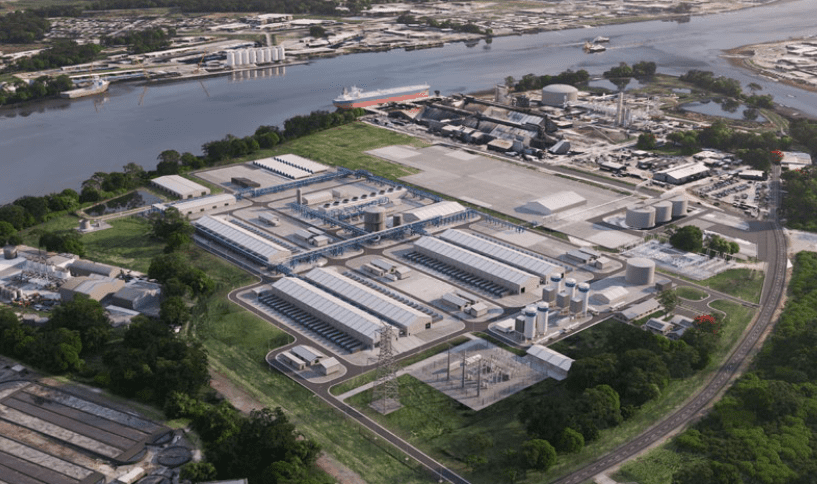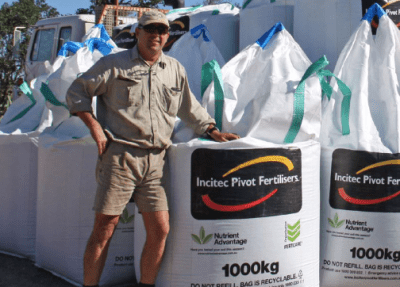
An artist’s impression of the Gibson Island project, with FFI’s proposed electrolysis plant as the maker of green hydrogen, at centre. Image: IPL
A DECISION on the future of Incitec Pivot Limited’s plans to produce green ammonia at its Gibson Island facility is expected by the end of next month, IPL said in its Climate Change Report 2023 released this week.
Known as the Gibson Island Green Ammonia project, the proposal involves IPL as the ammonia manufacturer, and Fortescue Future Industries as the producer of green hydrogen from a co-located facility.
Support needed for GI
The project has already received $13.7 million from Australian Renewable Energy Agency (ARENA) to help fund preliminary design, and the IPL report said the project will require government support to proceed.
“Should it secure this, it will be Australia’s first industrial-scale green ammonia-production facility, demonstrating existing infrastructure can be retrofitted to utilise zero-emissions energy sources,” the report said.
However, the plant will not produce urea, and IPF has moved to a full-import model ahead of its Perdaman facility in Western Australia coming on stream.
In introducing the report, IPL interim CEO Paul Victor went further.
“If approved, as far as we are aware this will be the first world-scale conversion of an existing ammonia manufacturing facility to renewable ammonia production,” Mr Victor said.
Gibson Island was Australia’s only manufacturer of urea, and closed last year after 50 years of operation as an ammonia-producing site, with IPL citing its inability to secure an affordable long-term supply of natural gas from Australian producers as the reason.
IPL said the revamped Gibson Island would generate a 44-percent reduction in Incitec Pivot Fertilisers’ 2020 baseline emissions through using renewable energy rather than a fossil fuel to produce ammonia.
It would also generate a 17pc reduction from the 2020 baseline for IPL, which includes the separate Dyno Nobel explosives division.
The proposed FFI water electrolysis facility would produce up to 70,000 tonnes of renewable hydrogen per year and replace all of Gibson Island’s current gas feedstock and 99pc of its natural gas energy use, with the hydrogen expected to go to export and possibly domestic markets.
“The Gibson Island Green Ammonia project could play an important role in developing Australia’s hydrogen potential,” the report said.
It added that green hydrogen was not expected to be price-competitive with natural gas for ammonia made for traditional uses until around 2040.
However, the report said ammonia made with green hydrogen has the potential to contribute significantly to the decarbonisation of energy systems and heavy-vehicle transport.
It would do this by offering a “practical, carbon-free way to store and transport the hydrogen” in a safer form as ammonia, as well as being a green fuel in its own right.
IPF is a major supply of fertiliser in eastern Australia, and one of Australia’s largest domestic manufacturers and suppliers of fertilisers by volume produced from its manufacturing facilities.
These include the ammonium phosphate fertiliser plant at Phosphate Hill in north-west Queensland, and the Geelong Single Super Phosphate manufacturing plant in Victoria.
Enhanced efficiency products on offer
In its accompanying Sustainability Report 2023, IPL said its Enhanced Efficiency Fertiliser (EEFs) range has been shown to reduce greenhouse gas emissions from fertiliser use on farms by up to 76pc in one instance.
In the report, IPL said EEFs work by keeping nitrogen in stable forms in the soil for longer, optimising their uptake by plants and reducing the risk of nutrient run-off and losses to the air as nitrous oxide.
This year, IPL participated in an industry association review to submit a method to formally quantify the GHG reductions associated with EEFs, and has been promoting the use of these products and working with customers to help optimise their use.
“A core part of this approach is a go-to-market strategy to engage with and inform farmers and so drive greater demand,” the report said.
“To ensure customers get access to the products they need, we have upgraded investment to provide the coating and blending capacity required for greater EEFs sales.
“We are also making enhancements to our supply chains to source ingredients to meet growing EEF demand.”

IPF is a leading supplier of broadacre fertiliser in Australia. Photo: IPL
IPL is a lead partner in the Australian Research Council-funded Hub for Smart Fertilisers, and has investing nearly $4 million in it to date.
The focus of hub research is on increasing nitrogen use efficiency) through a better understanding of how plants capture and use nutrients.
“Because improved NUE also reduces our customers’ on-farm greenhouse gas emissions, these will also reduce IPF’s downstream scope 3 emissions.”
“We have also continued our work on developing silicon-based fertilisers that have been shown to increase stress resistance in crops and replace silicon lost from soils in certain crops.
“The results to date suggest these products may improve crop tolerance of abiotic stresses, such as heat stress, which may be of value in a warming world.”
Fortescue makes capital move
FFI’s parent Fortescue last week announced the formation of Fortescue Capital as a green energy investment platform.
Headquartered in New York City, it seeks to bring outside capital into Fortescue’s green energy projects and decarbonisation investments.
“Fortescue is taking its global pipeline of green hydrogen and green ammonia projects to Final Investment Decision, and in doing so has communicated our intention and desire to bring additional equity investors on board,” Fortescue Energy CEO Mark Hutchinson said in a statement.
“Fortescue has previously communicated its planned investment to decarbonise its Pilbara operations, and we see Fortescue Capital as an essential tool of engagement as we embark on both missions.”
Potential capital partners include sovereign wealth funds, pension funds, endowments, insurance companies and ultra-high net worth family offices.
Fortescue’s operations are centred on iron ore mining in WA’s Pilbara region, where the company is already working on transitioning to hydrogen to power its fleet.
In July, Fortescue bought the Phoenix Hydrogen Hub, a proposed green-hydrogen project in the US state of Arizona, and last month it became a shareholder in Nordic green-hydrogen company Norwegian Hydrogen.
Source: Incitec Pivot Limited, Fortescue



HAVE YOUR SAY